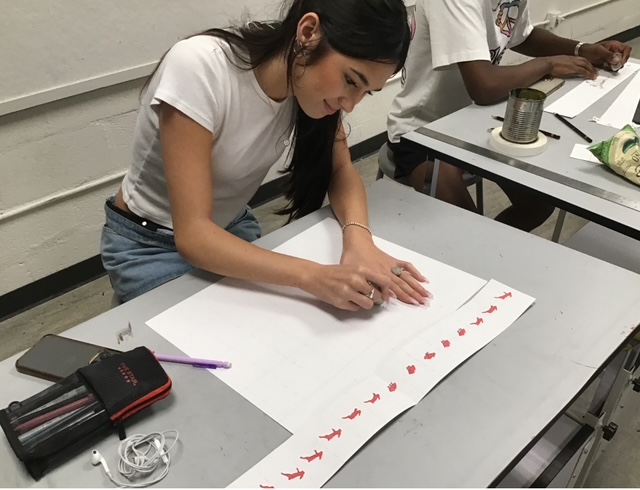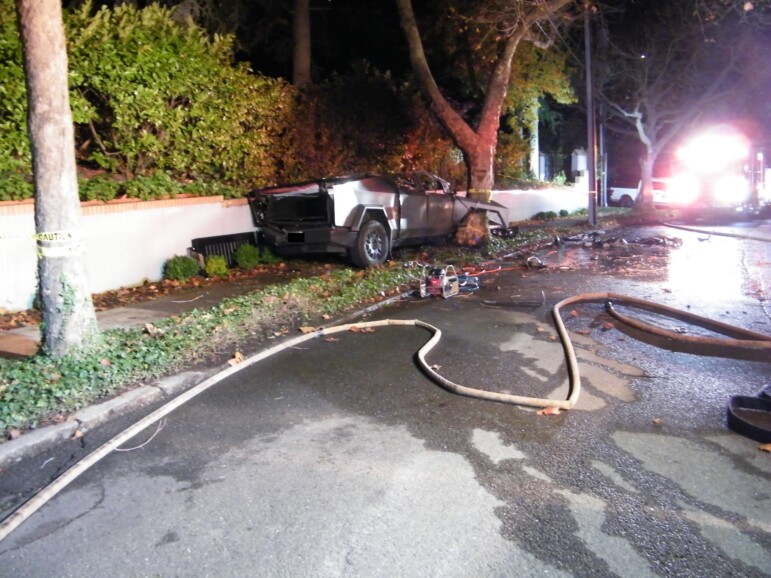The family of Krysta Tsukahara, one of three Piedmont High School graduates who died in a fiery Cybertruck crash in Piedmont on November 27, 2024, has filed a wrongful death lawsuit naming the estate of driver Soren Dixon, who also died in the crash, as well his grandfather Charles Patterson, who was the registered owner of the vehicle.
The suit was filed in Alameda County Superior Court on April 23.
“The whole objective at this point is to get more information,” Carl Tsukahara, father of Krysta, said. “Through a number of means our attorney has asked for information and has been stonewalled by some of the other parties.”
Seymour Everett, who is representing the Dixon and Patterson families, released a statement on April 25 saying that his clients have provided “full cooperation” with the investigation.
“The grief experienced by all the families involved is profound and immeasurable,” the statement read. “The Dixon and Patterson families extend heartfelt condolences to the families involved and to the entire Piedmont community. While fully respecting the Tsukaharas’ desire to seek answers, it is important to note that full cooperation has been provided throughout this investigation and will continue moving forward.”
When shown the statement, Roger Dreyer, attorney for the Tsukaharas said, “All I can say is their statement is contrary to reality. We have asked for them to provide us access to the vehicle and Tesla’s data. We have been ignored.”
Up to this point, none of the families of the deceased has commented publicly on the accident, instead asking for privacy. With the filing of the lawsuit, the Tsukaharas wanted to come forward, mostly to talk about their daughter. Carl and Noelle Tsukahara spoke to the Exedra via speakerphone on April 24 with Dreyer present. They spent a large chunk of the day speaking to multiple media outlets.
Kind and creative, with a flair for fashion
“She was very funny,” Carl Tsukahara said of Krysta as a young girl. “Extremely theatrical but also private. She would do funny little skits with her friends, little dances, singing. She loved to have fun, doing dress up and mimics. She was exceptionally funny and had a great sense of humor. On the other hand, around people she was less comfortable with she could be quiet. She could be shy.
“She was a very engaging personality once you got beneath the hood.”
Noelle Tsukahara told of multiple parents who approached her to remark on her daughter’s kindness. A friend might have had trouble with other students and Krysta would welcome her into her group of friends.
“It has been so lovely to hear all of these amazing stories that other people were able to share,” Noelle Tsukahara said.

Krysta Tsukahara played several sports as a kid. She would golf with her father and played on the Piedmont High golf team. She also played soccer and lacrosse as a child. She enjoyed dance, including everything from tap to hiphop, and performed at a dance school in Lafayette.
Carl Tsukahara said he and his daughter shared a love of music including vinyl records.
She also got into fashion, which led to her attending the Savannah College of Art & Design in Georgia where she was majoring in fashion design. She was 19 and a sophomore at the time of her death.
Carl Tsukahara said he noticed the interest around middle school.
“She would wear different clothes, I think, to be funny,” he said. “Crazy outfits, goofy hats. When she got to middle school and high school we kind of realized this was something important for her.”
Said Noelle Tsukahara, “She taught herself how to sew during COVID. She loved going to consignment stores. She would come back and design a different outfit with her eyes.”
She added about her daughter in college, “She loved it. She was thriving.”
Krysta Tsukahara brought a classical taste to fashion that her father compared to her enjoyment of vinyl records.
“She really appreciated history and things that were durable,” Carl Tsukahara said. “She didn’t like fast fashion. It’s a waste of fabrics. She was into durable fashions. The classic bag, the classic shoes. I spent a ton of time talking with her about what mark she wanted to make in the industry.”
Family seeks more information about circumstances surrounding the crash
The lack of information is the motivation for the lawsuit, Carl Tsukahara said. Dreyer said that Patterson, the registered owner, has not granted permission for inspection by the Tsukahara family. The vehicle is in the possession of the California Highway Patrol as it continues its investigation, according to Piedmont Police Department Captain Chris Monahan.
“Just getting the information from the car is something we can’t get unless the Pattersons give us the information,” Dreyer said. “Or from Tesla. We need the owner to cooperate. We’ve been in contact with the lawyers for the owner and we have just been stonewalled.”
He added, “We’ve got to look at it. We’ve got to see it.”
The accident happened a little after 3 a.m. on November 27 near Hampton Road and King Avenue. The vehicle jumped a curb, hit a restraining wall and a tree and ended up pinned between the two. Dixon, 19, Tsukahara and Jack Nelson, 20, were killed after a fire broke out in the vehicle. Jordan Miller, also a passenger in the vehicle, was pulled out by a friend of the group who was driving behind the Cybertruck.

California Highway Patrol photo of the crash site 
California Highway Patrol photo
Autopsies showed that Dixon had a Blood Alcohol Concentration (BAC) of 0.195 percent, well over both the legal limit for drivers under 21 (0.01) and all other drivers (0.08). Dixon also had cocaine in his system.
The San Francisco Standard reported on April 24 that Dixon had gotten a speeding ticket for going 102 miles per hour in a 65 mile per hour zone near the Dumbarton Bridge in 2023. The story said the violation was dismissed after Dixon took a CHP driver education class. The CHP report on the Cybertruck accident said that unsafe speed was a factor in the crash.
The report said the group of friends had been at a gathering of about eight people prior to the accident. Those eight included all four who were in the Cybertruck as well as two witnesses who were following behind in a second vehicle. There, according to a witness statement by the male that pulled Miller out of the car, Dixon had consumed “eight” drinks including beer and vodka.
A police bodycam video obtained by KTVU showed that witness telling an officer after being asked if Dixon was able to drive, “Legally, no. Physically, from a physical standpoint, yes.”
The Tsukaharas said one of the reasons they decided to go public now was that they felt some of the coverage of the accident has been unfair to their daughter. The autopsies showed that Nelson and Krysta Tsukahara had alcohol and cocaine in their systems too, but Tsukahara had a BAC of just 0.028, far less than Dixon and Nelson (0.168).
“Her blood alcohol was 0.02,” Carl Tsukahara said. “She didn’t meet those kids until later in the night.”
Dixon did not have the Cybertruck when he went to the get together. Instead, he asked the witness who pulled the survivor out to drive him to his house to get the vehicle, according to the witness’s statement after the crash.
“Why did this happen,” Carl Tsukahara asked as one of several questions he wants an answer to. “Why did the driver have access to the car? Where were the kids that night?”
Cybertruck safety questions
The lawsuit names multiple Does, unnamed potential defendants, which is standard. One question is could Tesla be added as a defendant. The witness that pulled Miller out could not immediately open the vehicle when he came upon the scene. Cybertrucks do not have standard door handles and the windows are reportedly near bulletproof. The witness eventually found a tree branch that was about four inches in diameter and “four-five feet long,” according to his statement.
“I used it to bash the window, it took 10-15 hits of the window to crack completely and the top right corner to pop out of its frame. I then grabbed the window and pulled it out of the frame,” the statement read.
He got Miller, who was sitting in the front passenger seat, out. He then attempted to get Krysta Tsukahara, who was sitting in the rear passenger seat, out but first had to smash the rearside window with the branch. By then, he said, the flames in the car were too intense to get to Tsukahara.
Cybertrucks have a safety release that can be pulled from inside each door, which is the subject of YouTube instructional videos but there is no way to know if any of the occupants were aware of it.
“Anybody’s possible,” Dreyer said of future defendants. “That’s why we’re doing discovery to find things out. I don’t want to implicate anybody.”
He added, “I think a bigger issue is why wasn’t she able to open up that door. We don’t know. We need to know why the vehicle caught on fire. This is an electric car.”
A similar Cybertruck crash involving the son of former Warriors star Gilbert Arenas happened early in the morning of April 24 near Los Angeles. Alijah Arenas, one of the top basketball recruits in the country, lost control of his Cybertruck near Reseda and ended up hitting a fire hydrant with the vehicle pinned against a wall on the sidewalk. Arenas was pulled from the burning vehicle, taken to a local hospital and put into an induced coma due to smoke inhalation.
The three victims of the Piedmont crash all died of smoke inhalation and asphyxia. The impact of the crash was not cited in the autopsy report released by Alameda County.
